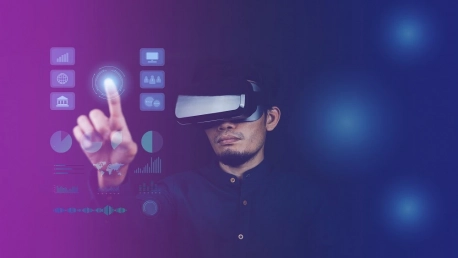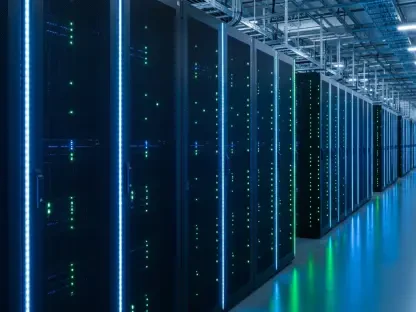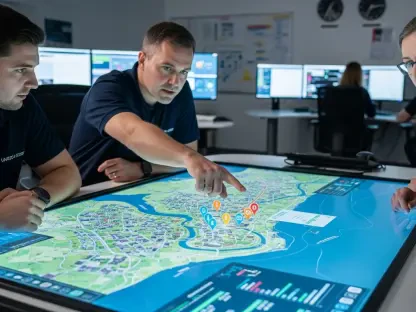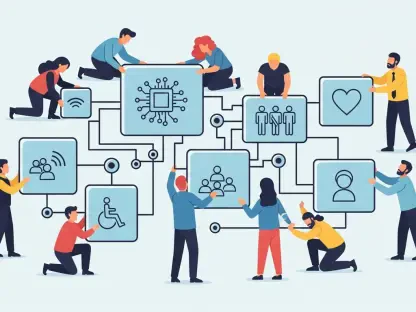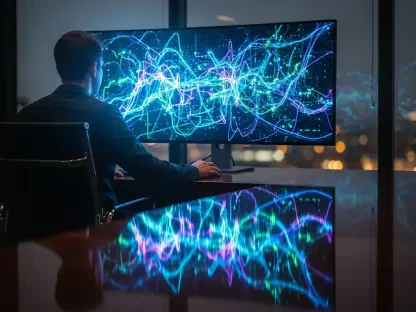The media and entertainment industry stands at the brink of a significant evolution, driven by advancements in artificial intelligence (AI). Particularly noteworthy is the integration of AI with virtual reality (VR) and augmented reality (AR), promising to revolutionize media production, storytelling, and user experiences. As both VR and AR continue to develop and mature, the combined force of these technologies with AI is expected to reshape the way content is created, distributed, and consumed. From enhancing the visual and emotional quality of CGI scenes to automating labor-intensive tasks, AI’s influence spans the entire production pipeline, making creative processes more efficient and accessible.
AI-Driven Enhancements in Media Production
AI-powered tools are transforming the creation and distribution processes within the media sector, making production more efficient and creative. Disney’s FaceDirector, for example, allows for the generation of composite actor expressions from multiple takes, enhancing emotional precision in computer-generated imagery (CGI) scenes. This tool was notably used in high-profile films such as “Avengers: Infinity War,” demonstrating its efficacy in providing filmmakers with a powerful way to fine-tune performances and storytelling.Moreover, deepfake technology has made significant strides, enabling realistic face-swapping and de-aging of actors, as exemplified in the film “The Irishman.” These advancements provide cost-effective alternatives to traditional digital effects, allowing filmmakers to push the boundaries of what is visually possible without prohibitive expenses. This kind of technology not only saves substantial amounts of time but also broadens the scope for creative expression by allowing the depiction of scenarios and characters that would otherwise be impossible or prohibitively expensive to produce.AI systems have also optimized labor-intensive tasks like color grading and editing. IBM’s Watson, for instance, has been employed to analyze elements from other movie trailers to craft effective promotional content, showcased in the film “Morgan.” Such tools not only enhance the quality of output but also reduce the time and costs associated with traditional methods. By leveraging AI in these areas, media producers can focus more on the creative aspects of their work rather than getting bogged down by the technical, repetitive processes that typically consume a significant portion of production time.
Generative AI in Creative Processes
One of the most remarkable applications of generative AI models is their ability to create realistic digital imagery from simple text descriptions. Generative models like DALL-E 3 can produce intricate and imaginative visuals, revolutionizing worldbuilding for animated films, games, and VR/AR experiences. This capability simplifies and democratizes the creative process, enabling even small studios and independent creators to produce high-quality content without needing extensive artistic resources or technical skills. Such technology paves the way for a more diverse and vibrant media landscape, where different voices and visions can be actualized.The potential for generative AI extends to the creation of digital human characters and virtual actors. AI systems can generate photorealistic faces and customized video clips, making it possible to create characters with unlimited expressive range and mobility. This innovation promises to be a game-changer for live VR broadcasts, immersive theater performances, and real-time rendered experiences, offering authentic and engaging digital personas. These AI-generated characters can interact with live performers and audiences in real time, providing a level of engagement and interactivity that was previously unattainable.By embracing generative AI, the media and entertainment industry is positioned to explore new forms of creative expression, pushing the boundaries of traditional storytelling and visual design. This technology allows for the creation of immersive environments and narratives that can adapt to user interactions, making the experience more personal and impactful. It also provides tools for experimentation, enabling creators to try out different ideas quickly and see what works best without the cost and time constraints of traditional methods.
Infinite Virtual Worlds and Real-Time Rendering
Modern game and VR engines have made significant strides in rendering realistic 3D environments in real time. Traditionally, these virtual worlds are handcrafted by numerous artists and level designers, a time-consuming and resource-intensive process. Generative AI models, however, introduce the possibility of creating boundless, coherent 3D environments from text descriptions. This technology could lead to the development of vast, open-world games and VR landscapes that are unique to each user, enhancing the personalization and immersion of digital experiences. Each interaction with the environment could be unique, tailored to the user’s preferences and actions.These AI-generated worlds can adapt and expand based on user interactions, offering a dynamic and ever-evolving environment that traditional game design could never achieve. This capability allows for a more engaging and interactive media experience, where the user’s choices and actions directly influence the narrative and environment. Such adaptable worlds could also maintain a high level of consistency and coherence, making them more believable and immersive.The capability to generate infinite virtual worlds also presents opportunities for educational and training simulations, allowing users to explore and interact with simulated environments in a deeply immersive way. This transformation in virtual world creation is set to redefine the standards of interactive entertainment and educational tools. For instance, medical students could practice procedures in a simulated real-world environment, or history students could explore ancient civilizations firsthand, all created dynamically by AI to provide the most relevant and accurate experience possible.
AI in Content Moderation and Digital Rights Management
As AI-generated media proliferates, the need for effective content moderation and digital rights management (DRM) technology becomes increasingly urgent. Major platforms are implementing AI systems to detect unauthorized use of copyrighted audio, images, and videos. These systems can analyze content at a granular level, identifying copyrighted elements embedded within larger media assets. Such technology is crucial in maintaining the integrity of content distribution and upholding legal and ethical standards in media production and consumption.Future developments in AI could allow generative models to assess the provenance and ownership of media components, ensuring proper licensing and credit are maintained. This capability is essential in combating issues related to copyright infringement and misinformation, which are prevalent in the digital age. By providing a detailed analysis of content origin and modification history, these AI systems would enable more transparent and fair use of digital media, protecting both creators and consumers from the consequences of unlicensed and misleading content.Advanced content moderation technologies are also crucial in maintaining the integrity of user-generated content, preventing the spread of deepfakes and other manipulated media that could mislead audiences. By ensuring the authenticity and legality of AI-generated media, these systems will play a vital role in upholding ethical standards in the media and entertainment industry. They can sift through vast amounts of content quickly and accurately, identifying and flagging potential issues before they can do harm.
The Role of AI in Democratizing Media Production
The media and entertainment industry is on the brink of a profound transformation, thanks to the rapid advancements in artificial intelligence (AI). One of the most exciting aspects of this evolution is the synergy between AI, virtual reality (VR), and augmented reality (AR). This powerful combination is poised to revolutionize how media is produced, stories are told, and content is experienced by users. As VR and AR technologies continue to evolve, their integration with AI is expected to dramatically reshape content creation, distribution, and consumption methods.AI’s influence in media production stretches from improving the visual and emotional quality of computer-generated imagery (CGI) scenes to automating tasks that were previously labor-intensive and time-consuming. This not only enhances the efficiency of the creative process but also makes advanced production techniques more accessible to a wider range of content creators. With AI, the boundaries of storytelling are being pushed, allowing for richer and more immersive experiences that captivate audiences in new and exciting ways.Overall, the fusion of AI with VR and AR represents a paradigm shift in the media and entertainment landscape. It holds the potential to make creative processes more efficient, reduce production costs, and open up new avenues for innovative content creation, ultimately setting the stage for a more immersive and dynamic future in entertainment.
